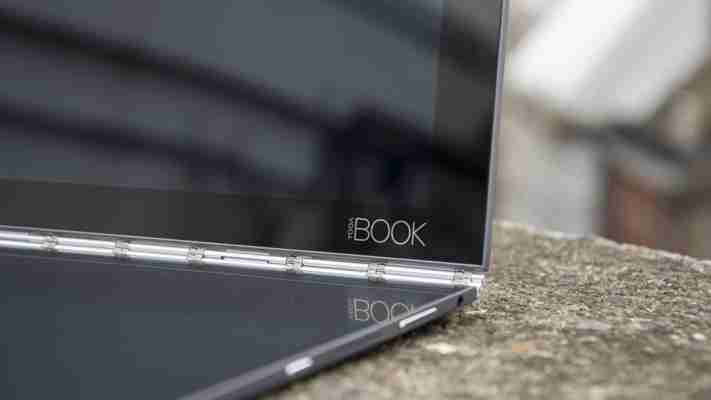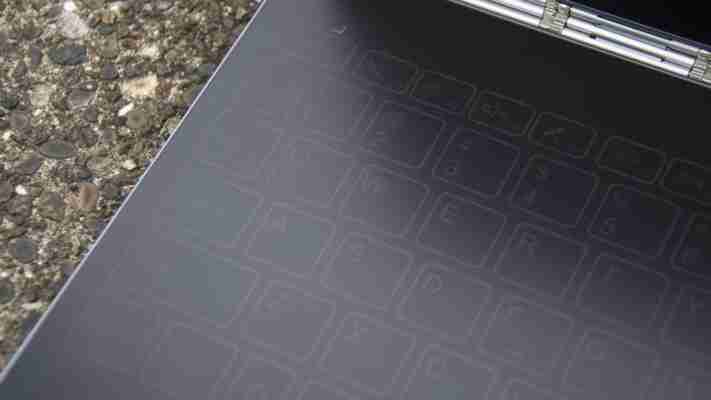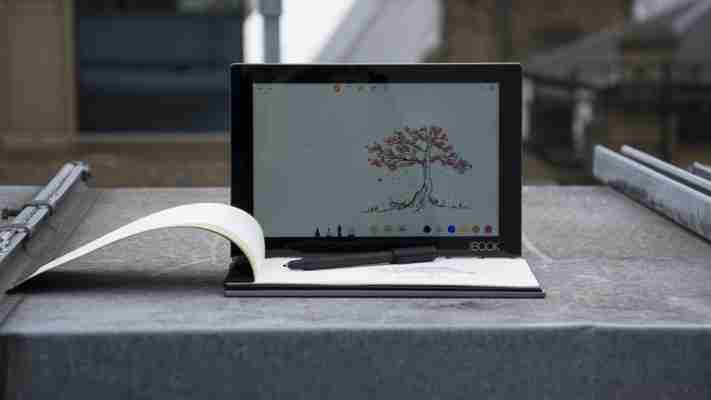Lenovo Yoga Book no longer being manufactured?
It's bad news for the 2-in-1 we all thought would pay the way for the next generation of laptop. It's beginning to look like Lenovo's Yoga Book is no longer being manufactured, with Lenovo's official website indicating that both the Android and Windows-powered Yoga Books are out of stock.
That said, you can still pick up the Yoga Book from John Lewis and Argos for £450 , although how long this will last is anyone's guess – so best act fast if you've had your eye on it recently. We've received no official word about the Yoga Book from Lenovo, and it may well be that the firm is gearing up for a possible Yoga Book 2 launch although, again, this is pure speculation.
My original Lenovo Yoga Book 2 review continues below.
Lenovo Yoga Book review
When the 2-in-1 Yoga Book was first announced, you'd have been forgiven for thinking that Lenovo had taken leave of its senses. As the manufacturer who first perfected the convertible laptop concept, though, Lenovo is no stranger to pushing the boundaries of laptop design – and it's got a pretty good track history of not getting it disastrously wrong in the process. This time around, it's raised the stakes higher than ever – the Yoga Book is by far the riskiest experiment yet.
For starters, there’s no physical keyboard. Instead, you get a fancy virtual one with illuminated, futuristic-looking keys that look as though they’ve been pulled straight from an episode of Black Mirror . They vibrate when you tap them, too, giving you a reassuring sense of haptic feedback as you type.
This isn’t a merely aesthetic touch, however, as the Yoga Book is able to turn that virtual keyboard into a full-blown, electromagnetic resonance (EMR) writing surface, allowing you to draw or scribble down notes with its bundled stylus at the flip of a switch. Simply press the small stylus button in the top-right corner and the illuminated keys instantly disappear.

It’s incredibly versatile, and the lack of physical keys means Lenovo has also been able to pare back the Yoga Book’s aluminium magnesium-alloy chassis to a mere 9.6mm when closed, making it the world’s thinnest hybrid. Likewise, at just 690g, the Yoga Book barely weighs more than your traditional paper notebook, making it incredibly easy to slot in your bag and use on the go.
Lenovo Yoga Book review: Halo keyboard
Admittedly, typing is a little awkward. At first, it feels like you’re learning to type for the first time – there’s just something about it that doesn’t quite feel natural. Stick with it, though, and you’ll get used to it pretty quickly. I wrote this review using the Yoga Book’s keyboard, and while the first draft was riddled with typos and mistakes, my fingers soon began to adapt. Just don’t expect to type very fast, as I found it wasn’t quite able to keep up the pace when I began to increase my overall typing speed – it's much more pleasant to type on than you might expect, but it's still no match for proper, old-school keys.
Theoretically, typing on the Yoga Book should improve over time, as Lenovo’s said it has artificial learning software built in. I didn’t see much, if any, evidence of this taking effect during my testing period, but it should be able to learn exactly where your fingers land when you hit certain keys and adjust its active key area accordingly. For instance, if you always hit the spacebar below the defined area on the keyboard, the Yoga Book should remember that and still register the keypress for you.

Turn the keyboard off, though, and the Yoga Book excels as a proper note-taking device. Using the stylus to draw and take notes feels perfectly natural, with near 1-to-1 precision thanks to the pen’s 2,048 levels of pressure sensitivity. I much prefer it to writing directly onto glass, and the keyboard’s built-in palm rejection means you can naturally rest your hand on it without making any random marks on the page.
It’s actually very similar to Wacom’s Bamboo Spark notepad, which also used an EMR surface to track individual pen strokes on a pad of paper before turning them into digital notes to view on your phone or tablet. Here, you get the added benefit of seeing exactly what you’re writing on the screen above.
However, the really attractive thing about the Yoga Book is its bundled magnetic clip. This allows you to clip any old A5 notebook to the Yoga Book and still take notes, giving you both a physical version and a digital copy to share with friends or colleagues. In the Android model I was sent for review, all my notes were instantly saved into Lenovo’s proprietary Custom note saving app, but the Windows version automatically saves everything into OneNote, allowing you to access it instantly from any Windows device via the cloud. This is by far the best way to use the Yoga Book, and is perfect for the frequent minute-takers who need both physical and digital copies of important notes.
Lenovo Yoga Book review: Display
Despite the fancy keyboard and effective stylus, Lenovo hasn’t done quite so well with its display. It has a 10.1in, 1,920 x 1,200 panel at its disposal, but despite a surprisingly high maximum brightness of 422cd/m2, its overall colour accuracy was a little lacking, covering just 81.2% of the sRGB colour gamut. This makes it a poor fit for serious graphic work, but considering its price of just £450, it seems churlish to be too harsh on it.
Lenovo Yoga Book review: Performance and battery life
As previously mentioned, there are two types of Yoga Book available – an Android version and a Windows 10 Pro version for £100 more – but both come with the same specs. This includes a quad-core Intel Atom x5-Z8550 processor clocked at 2.4GHz with 4GB of RAM. It’s not a particularly fast combination by any means, but it’s more than enough for light computing tasks on the move.
In Geekbench 4, for instance, the Yoga Book scored 3,222 in the multi-core test and 1,162 in the single-core test. This is a little on the low side for a laptop, but should serve you well for general use. In practicality, I didn’t have any noticeable issues when zipping around multiple, less demanding applications, only with the keyboard struggling to recognise fast keypresses on occasion.

Graphics performance wasn’t quite so impressive, but that’s hardly surprising given its svelte dimensions. That said, its average of 19fps in the GFXBench Manhattan 3 onscreen test is still pretty impressive, putting it roughly on par with one of last year’s flagship smartphones. In practice, running Sky Force Reloaded was a little problematic, with the occasional noticeable frame drop whenever the action got a little too frenetic, but simpler games such as Threes ran perfectly fine.
Battery life is pretty good, too. With the screen brightness set to our standard measurement of 170cd/m2, the Yoga Book lasted 7hrs 22mins in our continuous video-playback test, giving you a decent day’s use away from the mains.
Lenovo Yoga Book review: Ports and connections
Of course, a natural downside of having such a thin device is its sheer lack of ports. Still, the Yoga Book tries its best, as you get a micro-USB port, a micro-HDMI output for connecting it to an external display, and a 3.5mm headphone jack. As far as network connectivity goes, there's built-in 802.11ac wireless, along with Bluetooth 4 to hook up some external peripherals.
Lenovo Yoga Book review: Verdict
Despite a couple of niggles, the Yoga Book is an exceptional note-taking device that, for £450, does an excellent job of bridging the gap between laptop, tablet and notebook. Lenovo should be applauded for pushing the boundaries here, and it genuinely feels like a step forward over the various Surface and Surface Pro-alikes that have come and gone in recent years.
You also get more for your money than the now aged Surface 3 , as Microsoft expects you to spend extra on a keyboard and stylus – both of which come as standard with the Yoga Book. Admittedly, I’d probably be more inclined to go for the more expensive Windows version of the Yoga Book over the Android model on test here, and not least for the much wider selection of stylus-friendly creative applications, but the Android version may still be a good fit for those who regularly use Google Docs.
Whatever your thoughts on the Yoga Book, I’d advise trying out the keyboard before you buy, as the lack of physical keys certainly won’t be for everyone. However, if you're convinced that a convertible is for you, and you like the idea of it doubling up as a physical notepad, then the Yoga Book might be the laptop you've always wanted. For this kind of money, it's a steal.

| Core specs | |
|---|---|
| Processor | Quad-core 2.4GHz Intel Atom x5-Z8550 |
| RAM | 4GB |
| Memory slots (free) | 1 (0) |
| Max memory | 4GB |
| Dimensions | 256 x 170 x 9.6 |
| Weight | 690g |
| Sound | Dolby Audio Premium (3.5mm headset port) |
| Pointing device | Touchpad, touchscreen |
| Display | |
| Screen size | 10.1in |
| Screen resolution | 1,200 x 1,920 |
| Touchscreen | Yes |
| Graphics adaptor | N/A |
| Graphics outputs | 1 x Micro HDMI |
| Graphics memory | N/A |
| Storage | |
| Total storage | 64GB |
| Optical drive type | N/A |
| Ports and expansion | |
| USB ports | 1 x Micro USB |
| Bluetooth | 4.0 |
| Networking | Wireless 802.11a/b/g/n/ac |
| Memory card reader | MicroSD |
| Other ports | N/A |
| Miscellaneous | |
| Operating system | Android 6.0 |
| Operating system restore option | N/A |
